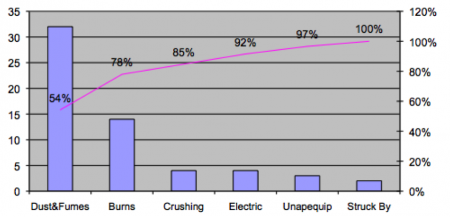Food Industry Related OSHA General Duty Clause Citations: Did you make the list? Now what?
OSHA General Duty Clause Citations: 2009-2012: Food Industry Related Activities
Doing a quick search of the OSHA Database for Food Industry related citations, it appears that Dust & Fumes along with Burns are the top driving hazard potentials.
Each citation fell under OSH Act of 1970 Section 5(a)(1): The employer did not furnish employment and a place of employment which were free from recognized hazards that were causing or likely to cause death or serious physical harm to employees in that employees were exposed……
Each company had to correct the potential hazard and respond using an Abatement Letter that includes words such as:
The hazard referenced in Inspection Number [insert 9-digit #]
for violation identified as:
Citation [insert #] and item [insert #] was corrected on [insert
date] by:
Okay so you have a regulatory finding and listed above is one of the OSHA processes to correct it, sounds easy right? Not so fast…..
….are the findings correct?
….if a correct finding, are you correcting the finding or fixing the problems that allowed the issue?
….is the finding a generic/systemic issue?
As many of our TapRooT® Client’s have learned, if you want a finding to go away, you must perform a proper root cause analysis first. They use tools such as:
o SnapCharT®: a simple, visual technique for collecting and organizing information quickly and efficiently.
o Root Cause Tree®: an easy-to-use resource to determine root causes of problems.
o Corrective Action Helper®: helps people develop corrective actions by seeing outside the box.
First you must define the Incident or Scope of the analysis. Critical in analysis of a finding is that the scope of your investigation is not that you received a finding. The scope of the investigation should be that you have a potential uncontrolled hazard or access to a potential hazard.
In thinking this way, this should also trigger the need to perform a Safeguard Analysis during the evidence collection and during the corrective action development. Here are a few blog articles that discuss this tool we teach in our TapRooT® Courses.
Monday Accident & Lesson NOT Learned: Why Do We Use the Weakest Corrective Actions From the Hierarchy of Safeguards?http://www.taproot.com/archives/28919#comments
Root Cause Analysis Tip: Analyze Things That Go Right … The After-Action Review
http://www.taproot.com/archives/43841
If you have not been taking OSHA Finding to the right level of action, you may want to benchmark your current action plan and root cause analysis process, see below:
BENCHMARKING ROOT CAUSE ANALYSIS
http://www.taproot.com/archives/45408




